Discovering the Temples & Shrines of Metoba – Part Three: Daianraku-ji

I’d left Chosho-ji via the south entrance. Not because I had any clear – or even vague – idea of which direction my tour of Metoba should go. I was just trying to soak up the sounds of those children singing somewhere within the walls of the kindergarten just south of the temple grounds. Their words were eager and angelic and entirely unintelligible. In a word, they were beautiful.
I drifted slowly away, down the narrow side street leading east. Their singing faded and disappeared as I turned the corner and pedaled north toward the massive Shinto torii gate a quarter mile up.
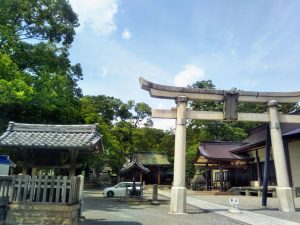
The Shinto torii is one of the most distinctive and visible differences between temples and shrines. Another is the presence of trees. Buddhist temples are at home in the middle of the concrete jungle. Shinto shrines require some semblance of Nature as an integral part of their surroundings. Their existence, then, is always marked by at least a few saplings if not a full-blown grove of cedars – and sometimes an entire forest. For this, I find myself drawn to shrines.
And for this, I almost missed Daianraku-ji.
Daianraku-ji isn’t your typical Japanese Buddhist temple. With its colorful four-sided rooftop turret, further adorned with a tall golden spire, this temple looks like it belongs in Kathmandu.

And while this multi-colored affair towering above its residential surroundings may be the first thing that catches the attention of the passerby, there are a great many things to notice and appreciate here on the grounds of the third temple on our Tour de Metoba.
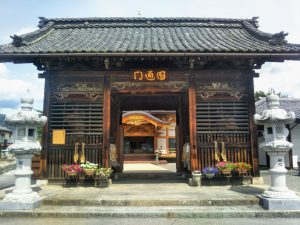
The gate fronting Daianraku-ji looks like the entrance to a barnyard as much as an invitation to enlightenment. In the dark its blank silhouette would catch nary a curious eye. But the details of this blocky wooden structure are enough by themselves to make the side trip to this temple worthwhile.
The characters above the gateway read right to left, and may look more like Sanskrit than Japanese-Chinese to the casual observer. They spell out, in the Japanese pronunciation, En-tsu-mon. Or Sono-dori-mon. Depends on your translation app. Either way, they mean ‘Garden Gate’. Considering the temple grounds resemble a converted parking lot more than a garden this name seems rather contrived. Maybe that was the impetus behind all the potted flowers.
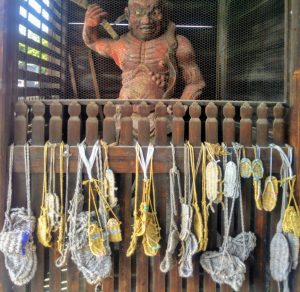
Hanging from the slats of this gate, a few on the front but most along the sides of the actual central passageway, are a dozen or two pairs of straw sandals – ‘waraji’ in Japanese. Tradition holds that these waraji would be woven by local people who would offer them to the temple for its continued protection, as well as to ward off the evil spirits lurking among the community, to bring happiness to the people, and to ensure that those passing this way will have healthy legs and feet.
The ideas about protection and safety and happiness make clear sense. But healthy hands and feet? And why hang them there in the throughway? Good questions, alert reader!
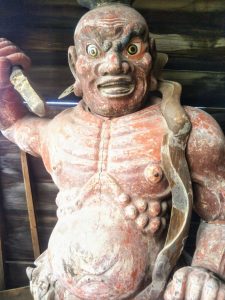
In the large chambers on either side of the gate are huge wooden demon creatures. Known in tandem as Nio, they are the twin deity protectors of Buddha, seen in temples all over Japan. Noticeably muscular and impressively pissed, they are considered to have particularly strong legs and feet. Thus it is no coincidence that all those sandals have been hung in front of the Nio twins. People will pray to them so that they will have not have any leg or feet problems (I guess this is some kind of ongoing national malady), and leaving a pair of sandals as an offering lends extra credence to their intentions.
Interestingly, some of the sandals offered to Nio are old and worn and, when they were presented, presumably quite smelly. Travelers and pilgrims will sometimes leave their used waraji at the temple of their destination as a sign of thanks after a successful journey, or for extra help and protection as they continue on their way. As waraji are made of straw, they can easily and quickly wear out, and when those pilgrims and travelers have more miles to go and need some new kicks they will trade in their old sandals for some new ones, right there at the temple. (So goes the story anyway.)
Around the back side of this Garden Gate more curiosities await. Behind the disintegrating chicken wire on one side is a wooden statue of a guy looking every bit as pissed off as the Nio boys. He has six arms, three eyes, two extra faces and flaming hair, and glares eternally angrily from atop a horse that has seen much better days.
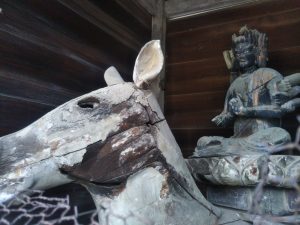
This is the Horse-Headed Kannon, one physical manifestation of the Goddess of Mercy who, in this form, is seen in Japan as the protector of animals. The Kannon goddess takes on many forms, but only in this form does this deity show rage – perhaps because this ‘Bato Kannon’ is also one of Esoteric Buddhism’s warlike and wrathful deities. Likely also related to the horse theme, this form of the Kannon was at one time significant to both samurai and farmers. Considering the samurai have gone extinct and the days of the Japanese farmer appear sadly numbered, refurbishing this Bato Kannon seems unlikely.
Hanging from the banisters bolted to the wall below the chicken wire on this and on the other side of the rear of this gate are rows of ‘ema’ – the wooden plaques seen at Shinto shrines all over Japan. Traditionally, most people in Japan purchase an ema as part of their first shrine visit of each new year. Wishes are written on the back, and the ema are then tied to a rack specifically designated for the purpose of assisting the realization of said wishes.
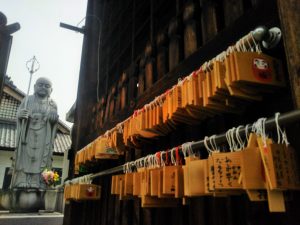
Inside the back of the other half of this Garden Gate a small gathering of wooden men sit meditating. Their peeling faces and the creepy grin worn by the guy in the middle reminds one, perhaps, of a cheesy Japanese horror movie.
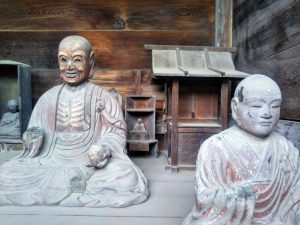
The main temple building, sitting off-center behind the gate, bears an ornate gold-plated – or maybe gold-painted – carving of a Phoenix above the central entrance. This Phoenix is the female counterpart to the ubiquitous Japanese dragon, seen in all its natural-wood glory closer toward the temple doors. Dragons, like the Nio twins, are considered guardians of the Buddha. They symbolize enlightenment and clarity, and are believed to have the power to control water and rain. For this reason they are the focus of prayers and thanks related to the yearly harvest.
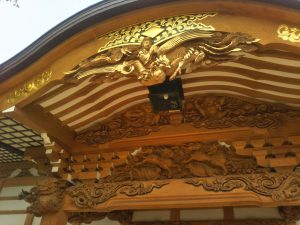
For an extra bit of dragon-related trivia, notice that this one has no wings. In Japan, dragons are represented as more like serpents with legs rather than the winged version common in other parts of the Buddhist world not to mention European lore and Disney-Pixar movies.
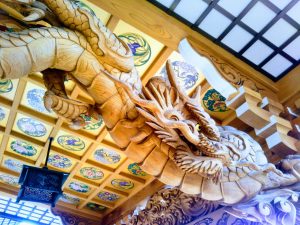
While Buddhism and Shintoism are both widely prevalent in Japan, they are for the most part kept manifestly separate. Occasionally, though, they will be placed directly alongside each other. We saw this at the first stop of our tour of Metoba, where Rinsho-ji Temple and Rinsho-jinja Shrine share a plot of land divided only partially by a cinder block wall. Here too at Daianraku-ji are there elements of Shinto. In this case they are right on the temple grounds, with no demarcating wall of any kind.
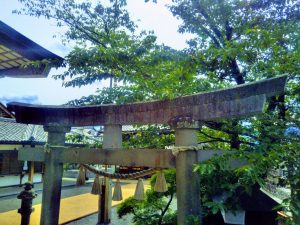
The Shinto torii almost seems out of place there in front of the left side of the temple’s façade. True to Shinto tradition, there are a couple of trees nearby to satisfy the requirement of Nature. In the shade of these trees are three stone ‘Jizo’ statues.
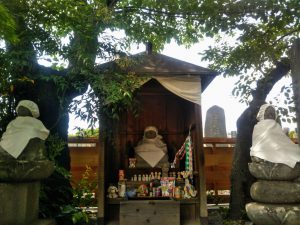
Jizo are actually Buddhist deities, sent to protect the souls of infant and unborn children. These poor tiny souls are granted entry to the afterlife by virtue of their pure innocence but cannot get there on their own. The jizo, then, are tasked with assisting them, sometimes hiding them under their cloaks and smuggling them past the demons who would wish to keep them in purgatory.
Jizo are also known as protectors of travelers, which could reasonably tie into the sandals offered to the Nio demons. But at least one of the jizo here at Daianraku seems tied only to the souls of those unfortunate children; at the feet of this particular jizo, seated in the small wooden shelter under the trees, is a bevy of sweet drinks, candy and stuffed animals.
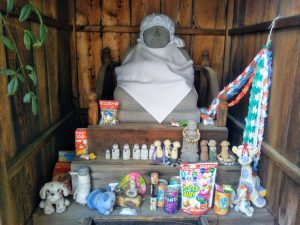
In Japan, at both temples and shrines, lucky charms can be had for a few hundred yen. Small, colorful, and exquisitely-woven, the ‘o-mamori’ normally available serve a variety of purposes, from well-being in the home to safety on the road to good luck to prosperity to protection from fire. In the window of the long, low building along the south side of the temple grounds was a neat and bright display of such o-mamori.
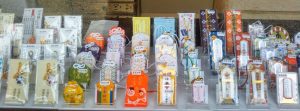
Alas, there was no one on hand here at Dai-an to assist me should I want to leave with one. There was also no one wandering the temple grounds. I was alone.
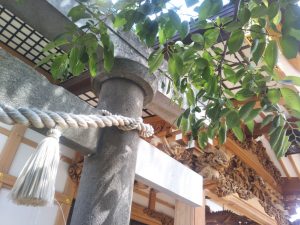
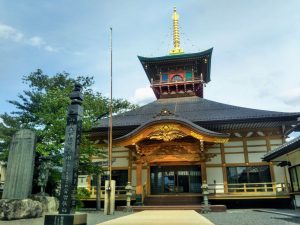
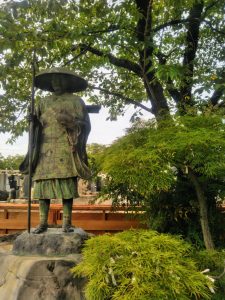
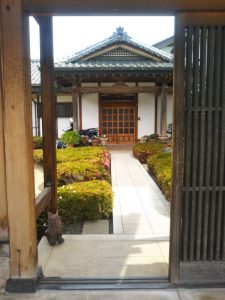
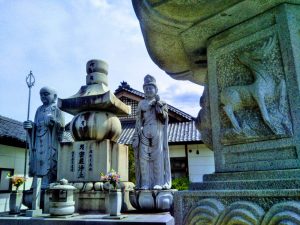
The sky was blue, the air was warm, and I had no pressing fatherly duties, so I opted to head back toward that big stone torii, visible against the trees on the far side of the sprawling cemetery to the north of Daianraku-ji. Maybe there would be a few people there…
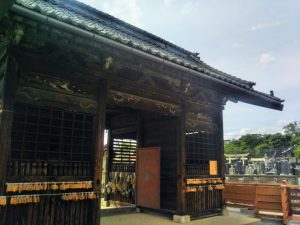
In case you’re still not familiar with the Metoba area —
[googlemaps https://www.google.com/maps/embed?pb=!1m14!1m8!1m3!1d3217.965255028894!2d137.97521772652954!3d36.24033798467194!3m2!1i1024!2i768!4f13.1!3m3!1m2!1s0x601d0e99d1703a37%3A0x98a8d1592a420fbc!2sTaiangakuji!5e0!3m2!1sen!2sjp!4v1561801047624!5m2!1sen!2sjp&w=600&h=450]